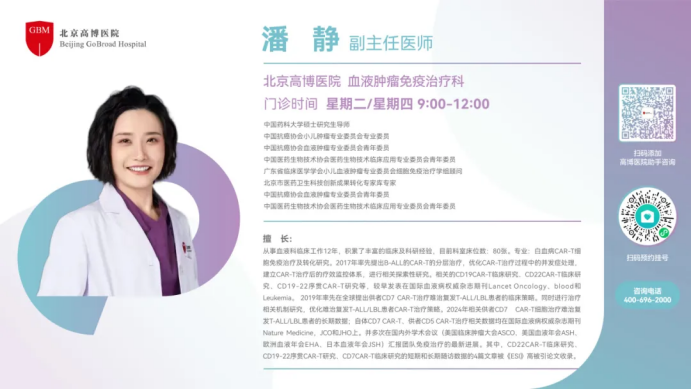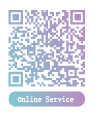Expert Guest Room | Professor Pan Jing: The Application of CAR-T Therapy in R/R T-ALL and B-ALL, Discussing Prognostic Factor Analysis and CAR-T Stratified Treatment System
From December 7–10, 2024, the 66th Annual Meeting of the American Society of Hematology (ASH) was held in San Diego, USA. As the largest and most comprehensive international academic conference in the field of hematology, it annually attracts numerous hematology experts and scholars from around the world to gather and engage in in-depth discussions and exchanges on major research advancements in hematology. At this year's conference, the research findings of Professor Pan Jing's team from Beijing Gaobo Hospital garnered significant attention. Two CAR-T therapy-related studies (Abstracts 964 and 3466) were selected for the conference, bringing forward many advancements. To gain a deeper understanding of these groundbreaking research findings, Tumor Outlook - Hematology News conducted a live interview with Professor Pan, focusing on these two studies and CAR-T therapy. Below is a summary of the research and interview content.
Hematology News
Q1: When CAR-T therapy was first introduced, it was regarded as a potential cure for diseases. After years of in-depth exploration, do you think the role of CAR-T therapy in hematologic cancer treatment has changed?
Professor Pan Jing: The therapeutic role of CAR-T cell therapy in hematologic malignancies has become increasingly solid. With the explosive growth of CAR-T products and clinical research advancements in recent years, CAR-T cell therapy is undoubtedly becoming more well-known. Although the progress in the CAR-T field has slowed down somewhat recently, at the just-concluded ASH meeting, there were significant updates on the cutting-edge advancements in CAR-T therapy, with some foundational and translational medicine research data being presented, showing promising prospects and hope. There is no doubt that CAR-T therapy is now recognized as a solution to some of the more challenging treatment issues in the hematology field, and its therapeutic position is becoming more important and stable. Its development relies on the overall integration of basic medicine, translational medicine, and clinical medicine.
Q2: Your research team has been continuously exploring CD7 CAR-T therapy in T-cell tumors. This year, your research was also selected for the ASH meeting. From the perspective of the researchers, what is the clinical value of this study?
Professor Pan Jing: In fact, at international academic conferences such as ASH and EHA, our team primarily reports the latest results of a series of studies. At this year's ASH meeting, our team presented two major areas of progress:
- In T-cell tumors, we analyzed survival prognostic factors in 75 patients who received CD7 CAR-T cell therapy for relapsed/refractory (R/R) T-ALL.
- In the B-cell tumor field, for patients with large central masses or high central tumor burden, our team is exploring the use of intrathecal CAR-T therapy, aiming to address some of the more challenging treatment issues in the hematology field.
Q3: At this year's ASH, your team presented a study on intrathecal infusion of CD19/CD22 CAR-T cells for treating CNS leukemia or relapsed/refractory (R/R) B-ALL patients with high central nervous system relapse risk. How do you view the value of CAR-T stratified treatment?
Professor Pan Jing: The CAR-T stratified treatment approach for B-cell acute lymphoblastic leukemia (B-ALL) is becoming increasingly clear, and the stratification factors are more defined. This is the result of nearly ten years of global CAR-T treatment practice data. Some studies presented at last year's ASH and this year's EHA meetings have already demonstrated the clinical value of the CAR-T stratified treatment system. In this system, correctly identifying high-risk relapse patients who need CAR-T therapy and then bridging them to allogeneic hematopoietic stem cell transplantation (allo-HSCT) is of great significance. In fact, our center proposed the concept of CAR-T stratified treatment early on, where some B-ALL patients could achieve a cure with CAR-T therapy, while others with high-risk relapse would need rapid bridging to allo-HSCT to improve survival. This stratified treatment system has been consistently followed and implemented. Relevant research data were published in BLOOD (Phase I study data from 2017-2018) and The Lancet Oncology (Phase II study data from 2019). For patients with central nervous system leukemia (CNSL), a sub-group of relapsed B-ALL, we have attempted intrathecal CAR-T therapy and explored the safety and timing of this treatment. Currently, we believe that administering CAR-T intrathecal injection after cytokine release syndrome (CRS) resolves is safe and manageable.
Q4: What is the future outlook for CAR-T therapy in China?
Professor Pan Jing: Some experts believe that China's CAR-T clinical research is already leading the world. First, Chinese researchers have rich clinical experience, and the patient population is larger, with a clinical trial management system that differs from that of other countries, giving China an advantage in CAR-T clinical research. However, it is also important to note that China has some weaknesses in basic scientific research and translational medicine, which are critical for providing pioneering ideas and breakthrough directions. In this regard, we are relatively behind, but we hope to "catch up" by integrating basic medicine with clinical research.
Abstract 964丨CD7 CAR-T-cell Therapy in Relapsed or Refractory T-cell Acute Lymphoblastic Leukemia-a Retrospective Study
Research Content
A retrospective study of patients with relapsed/refractory acute T-cell lymphoblastic leukemia (R/R T-ALL) treated with CD7 CAR-T cell therapy.
Abstract 964: CD7 CAR-T-cell Therapy in Relapsed or Refractory T-cell Acute Lymphoblastic Leukemia – A Retrospective Study
Objective
This study combines the results of two clinical trials (Phase I and Phase II) for a retrospective analysis aimed at further clarifying the survival prognostic factors for patients with relapsed/refractory acute T-cell lymphoblastic leukemia (R/R T-ALL) treated with CD7 CAR-T cell therapy.Methods
The Kaplan-Meier method was used to evaluate event-free survival (EFS) and overall survival (OS). Univariate analysis was conducted using the Log-rank test, and multivariate analysis was performed using the Cox regression model.Results
A total of 75 R/R T-ALL patients were included, with a median of 4 prior lines of treatment. Among them, 50 patients received CD7 CAR-T cell therapy from a previous hematopoietic stem cell transplant (SCT) donor after standard lymphodepleting therapy; 25 patients received new HLA-matched donor-derived CD5 CAR-T cells after intensified lymphodepletion. After CD7 CAR-T cell infusion, 26 patients underwent SCT for consolidation therapy.In univariate analysis, the results showed:
- R/R T-ALL patients who received SCT consolidation therapy had a 2-year EFS rate and OS rate of 51%, significantly higher than those who did not receive SCT consolidation therapy.
- R/R T-ALL patients without extramedullary disease (EMD) in the central nervous system had 2-year EFS and OS rates of 21% and 22%, significantly lower than those without EMD.
- R/R T-ALL patients with a blast cell percentage between 5% and 50% in bone marrow (BM) had higher EFS and OS rates than those with blast cells ≤5% or >50% (P values were 0.001 and 0.004, respectively).
In multivariate analysis using the Cox regression model, the results showed:
- SCT consolidation therapy (HR=2.24, 95%CI: 1.06–4.72, P=0.035) was significantly associated with better EFS.
- Non-central nervous system EMD (HR=0.45, 95%CI: 0.22–0.90, P=0.024), BM blast cells ≥5% but <50% (compared to blast cells <5%, HR=0.38, 95%CI: 0.18–0.84, P=0.016), and BM blast cells ≥50% (compared to blast cells <5%, HR=0.16, 95%CI: 0.06–0.42, P<0.001) were significantly associated with poorer EFS.
- Non-central nervous system EMD (HR=0.45, 95%CI: 0.21–0.95, P=0.036) and BM blast cells ≥50% (compared to blast cells <5%, HR=0.32, 95%CI: 0.12–0.91, P=0.033) were significantly associated with lower OS in R/R T-ALL patients.
Research Conclusion
Extramedullary disease (EMD) outside the central nervous system (CNS) and heavier tumor burden in bone marrow are independent risk factors for lower survival rates in R/R T-ALL patients treated with donor-derived CD7 CAR-T therapy. However, SCT consolidation therapy may bring survival benefits to these patients.
Intrathecal Infusion of CD19 and/or CD22 CAR-T Cells for CNSL or High-Risk CNS Relapse in R/R B-ALL: Safety and Feasibility Exploration
Abstract 3466: Safety and Feasibility of Intrathecal Infusion of CD19 and/or CD22 CAR-T Cells in r/r B-ALL Patients with CNSL or High-Risk CNS Relapse
Objective
This exploratory study was conducted through retrospective analysis to clarify the safety and feasibility of intrathecal infusion of CD19 and/or CD22 CAR-T cells in R/R B-ALL patients with CNSL or high-risk CNS relapse.Methods
A total of 26 R/R B-ALL patients were enrolled, including 14 with CNS1, 4 with CNS2, and 8 with CNS3, all of whom met the study's screening criteria. Enrolled patients received intravenous and intrathecal CAR-T cell therapy. After intravenous CAR-T cell infusion, 20 patients with CNSL received intrathecal infusion of CD19 CAR-T cells, and 18 received intrathecal infusion of CD22 CAR-T cells at a median of 15 and 27 days, respectively.Results
- After intravenous CAR-T cell infusion, 18 patients (69%) with CNSL experienced grade 1-2 CRS, 5 patients (19%) had grade 1-2 ICANS, and 1 patient (4%) experienced grade 3 ICANS.
- After intrathecal infusion of CAR-T cells, 8 patients (31%) with CNSL experienced grade 1-2 CRS, 4 patients (15%) had grade 1-2 ICANS, and 1 patient (4%) experienced grade 3 ICANS.
- Among 14 patients with no CNSL at baseline, 5 patients (36%) developed grade 1 CRS, 2 patients (14%) developed grade 1 ICANS, and 1 patient (7%) developed grade 3 ICANS after intrathecal CAR-T infusion. Among the 12 patients with baseline CNS2-3, 3 patients (25%) and 2 patients (17%) developed grade 1 CRS and grade 1 ICANS, respectively, after intrathecal CAR-T infusion.
- At a median follow-up of 10 months, 20 CNSL patients remained in continuous CR. Among 14 CNSL patients with baseline CNS1, 2 patients had bone marrow (BM) relapse at 5.2 months and 13.5 months, and 1 patient had BM and CNS relapse at 7 months. Among 12 patients with baseline CNS2-3, 1 patient had CNS relapse at 8.9 months, and 1 patient had BM relapse at 5.4 months.
Conclusion
This study included 26 R/R B-ALL patients with CNSL or high-risk CNS relapse. The results confirmed the safety and feasibility of using intrathecal CAR-T cell infusion for treating this patient group. The incidence of CRS and ICANS was similar in R/R B-ALL patients who received intravenous and intrathecal CAR-T cell therapy.
Expert Introduction
















